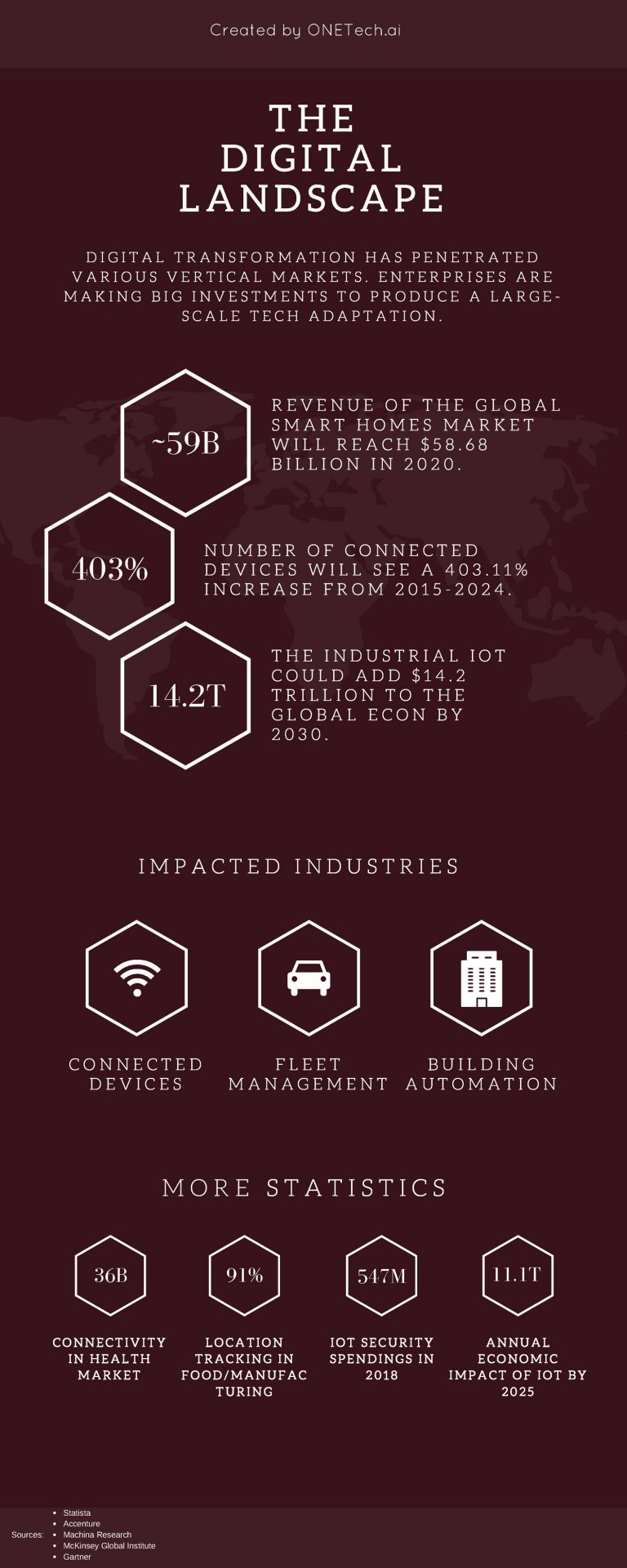
10 Aug Adapting to Digital Transformation
The concept of digital transformation is not new, but it is becoming more relevant as enterprises and startups look for ways to evolve their businesses. Digital transformation is moving to the forefront of everyone’s minds—and for good reason. From incorporating a faster and more efficient fleet-tracking technology to application delivery, digital transformation has become a permeating voice in the IoT realm. The digital disruption enables a faster time to market, reduction in optimization costs, and creation of a fluid business model.
Why Do We Need a Digital Disruption?
When examining an enterprise structure from a bottom-up perspective, it is easy to see that happy consumers are the foundation of any winning empire. Over the years, consumer appetite for service has grown so exponentially that only few industrial titans such as Amazon, Google, and Apple can satisfy it. Especially for urban consumers, the thought of waiting too long or traveling too far for a product is extremely off-putting. In a Google Consumer Survey conducted by Arise, the maximum wait time tolerated by consumers on the phone in 2014 went from 13-minutes to an astounding 2-minutes or less before they terminate the call. This attitude isn’t going away—and in all honesty, why should it?
Efficiently adapting to digital transformation will help businesses connect with their valuable consumers. For an enterprise to leverage itself to the heights of its competitors and beyond, the enterprise must embrace technology like IoT (Internet of Things) connectivity. Aggregating the massive amount of data generated by devices will allow for businesses to stay ahead of the curve and adopt a whole new engine to help engage with not only the customers, but more importantly, their preferences.
For companies that don’t deal with consumers on a day-to-day basis, being involved in business transformation still has significant advantages. Many companies share similar pain points which seeks answers on how to improve decision-making, digital consulting, communication, inventory management, asset tracking, and the like. Critically looking at these challenges will reveal that being digitally connected is the answer to many problems. Thus, a busy company that is internally connected with all its compartments will open new doors to optimizing intelligence and operations.
More Than Digital Marketing
Seeking inter-connectivity is more than just amassing raw data. Businesses that wants to adopt a digital transformation strategy should keep an open mind in order to meaningfully process data. With the implementation of IoT in these businesses, there will be room for more agility, less labor costs, opportunistic entrances to new markets, accessibility to premium customer service, and other bold potential applications. Companies with a transparent network of data will automatically market themselves as thought leaders of their industry.
Just how large is the framework of digital transformation for enterprises? There are applications that easily comes to mind, but other applications may strike a stealthier nuance. Smart devices such as identification tags, wearables, and smart home appliances can be manifested as the Fitbit or Amazon echo devices. To magnify the scale, you’d find that digital businesses has affected smart cities and connected cars. For example, Barcelona has found itself to be one of the world’s most IoT implemented metropolitan with smart parking and environment. Harnessing these tools and incorporating them with the cloud would enable enterprises to combat any paradigm shift in the market.
Breaking Down the Barriers to Success
As previously mentioned, the growth of nearly-insatiable consumer desires can be a tricky riddle for enterprises to solve. As multi-billionaire tech enthusiast Mark Cuban puts it, “TV is no longer the best alternative to boredom. To kids not old enough for Snapchat, music is the best alternative to boredom. For Snapchat users, it’s the best alternative to boredom.”(source) However, consumer behavior is hardly the biggest worry for companies wanting to adopt a digitized work model.
Similar to consumer behavior, the IT landscape is also continuously evolving. This makes it easy for companies to mistakenly mismatch technology, misunderstand emerging tech devices, or even become overwhelmed with having too much of an internal transformation. Ultimately, these factors can force an enterprise to reorganize their business model. However, it doesn’t always have to look so grim. If the goal is long-term growth, then the rewards will slowly but surely come.
The Digital Disruption
To say that the call for digital transformation is left unheard would be a vast overstatement. Indeed, businesses are starting to adapt their models to take advantage of digital advances such as big data analytics, IoT capabilities, AI in robotics and smart devices, device tracking, machine learning, and other countless spaces, and the interconnectivity of it all. The penetration of digital advancement, especially in the context of IoT, will hit hard from retail, manufacturing, fleet and asset tracking, banking, healthcare, and more. Undoubtedly, enterprises are making big investments to produce a large-scale tech adaptation.
Here is an infographic on how we may view the business world in the not-so-distant future.

